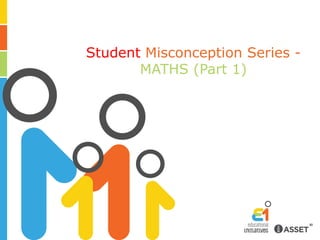
Student Misconception Series - MATHS (Part 1)
- 1. Student Misconception Series - MATHS (Part 1)
- 2. Do your Student Learn or Mug up ? Students of all ages seem to have a mind of their own when it comes to responding to any situation or performing any task. As teachers, most of us go back home thinking that our students have understood every concept that we teach them. It is only when we test them that we find that some concepts have not been understood as clearly as they should have been. It is this desire to understand student thinking that prompted us to examine ASSET questions of the past rounds, in Maths, examining the most common wrong answers to understand what could have made students select the options they did.
- 3. Measurement, DataInterpretation/Analysis: Averages and Graph Reading Class 3
- 5. Why was the question asked? This question was asked to test if students can understand the information given in the table and answer questions based on it. What did students answer? This question was asked to test if students can understand the information given in the table and answer questions based on it. 33.8% of students have answered B correctly and 30% have chosen the most common wrong answer D. Possible reason for choosing A: These students have answered the number of points scored by group 4. Possible reason for choosing C: These students have subtracted the numbers in the last 2 rows of the table. Possible reason for choosing D: These students have answered the number of points scored by group 2. They may probably have answered looking just at the last few words of the question or may have answered 40 as that is the larger of 27 and 40.
- 6. 3. Learnings This being a usual subtraction problem, it is quite surprising that only about a third of the students got it right. Probably when they saw the table, they may have assumed that they have to find some value from the table. Looking at the question they may have felt that the score of group 4 or group 2 is being asked. They have not been able to interpret the question correctly. If students' only experience with tables is limited to “read the value from the table” kind of problems, they may tend to interpret every problem in the same way. They find it difficult to understand the question, if it is slightly different from the ones they are used to seeing in the context, even though it is a familiar situation. Though they may be familiar with “how many more than ….” kind of problems in subtraction, they failed to recognize the situation and apply their knowledge here.
- 7. How do we Handle this? Students must be exposed to different types of questions and concepts made clear to them so that they can apply these to any new or different situation. In this question the teacher should investigate how the students interpreted the question, • Whether they thought that the scores of one of the groups was being asked and if so why? • Did they interpret the question properly? Or did they feel that that have to give the maximum of the scores of group 4 and group 2? • Did they recognize this as a subtraction problem? • Did they have any difficulty in framing the subtraction expression required to solve this problem and so picked out the scores of the teams instead? The teacher should make students aware that different types of questions can be asked from a given table and not just the “read the value corresponding to a category” type. From the given table she could ask them questions like: • Who won the quiz? • By how many points did the winning group defeat the group that came second? • Which team scored the minimum number of points? If they have had any difficulty in identifying this as a situation that calls for subtraction, the teacher should familiarize them with the different ways in which a subtraction problem can be posed with examples involving small numbers and situations familiar to them. The above problem could be modeled as “Tanya had 9 pencils and Sanya had 5 pencils. How many pencils more than Sanya did Tanya have?” She should also give them other subtraction situations like “Tanya had 9 pencils. She had 4 pencils more than Sanya. How many pencils did Sanya have?” and see if they are able to correctly frame the expression. Only through exposure to a variety of problems can students gain confidence in solving unfamiliar questions.
